Pickleball 2.0
News Based on facts, either observed and verified directly by the reporter, or reported and verified from knowledgeable sources.
With growth comes some growing pains. Six surprising challenges pickleball faces in Westchester.

Good morning! Today is Wednesday, February 23, and you are reading today’s section of Examiner+, a digital newsmagazine serving Westchester, Putnam, and the surrounding Hudson Valley.
Need to subscribe — or upgrade your Examiner+ subscription to enjoy full access to all of our premium digital content? Details here.

In part one of our two-part series on pickleball in Westchester, “Westchester Welcomes Pickleball,” I covered how the popular sport has finally hit a tipping point in our region, listing where and how to find places to play pickleball.
But as the sport hits the next level in our area, it’s also hit a few stumbling blocks big and small.
In suburban Westchester, a general sense persists that there is a scarcity of outdoor and especially indoor pickleball courts. The shared courts that do exist often give priority to school tennis practices or nighttime basketball leagues, while both new and advanced pickleball players jockey over limited court availability.
Court space has become less of a pressing issue in northern Westchester as the long-term organizing and town-hall advocacy by northern-based players such as USA Pickleball Ambassadors Jim Geary, Julie Vesei, Manny Boya, and Teresa Chang of Somers have resulted in more towns getting on the pickleball bandwagon the past few years. But southern Westchester lags behind, which may be due to some of the following challenges.
Challenge 1: Lack of space/property costs
To have vibrant programs, you need space for a cluster of courts. In wide-open Florida and Arizona, pickleball complexes are springing up that have 20 to 30 courts in one facility, often accompanied by a clubhouse hangout with a bar and restaurant.
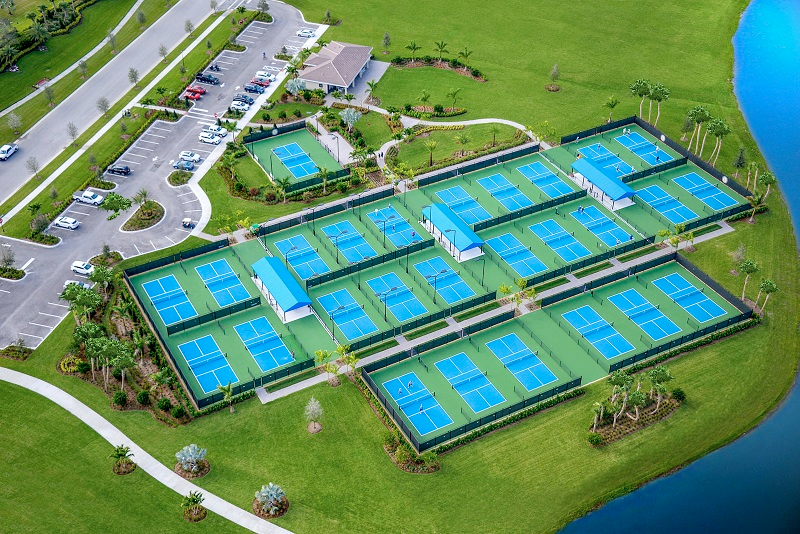
Overhead view of 27 scenic pickleball courts and a clubhouse in Port St. Lucie, Florida. (Photo: Kolter Homes)
Keep dreaming about that scenario happening around here anytime soon, especially in southern Westchester, where the land use is very dense and the cost of property is astronomical.
Some down-county parks, like Rye Brook’s Crawford Park, hand over their outdoor basketball courts with painted lines to pickleball players at specific times, but those b-ball courts are mostly meant for the town’s children, so p-ball time is limited. Therefore a lot of southern Westchester players find themselves traveling pretty far north to Granite Knolls’ 6 dedicated pickleball courts in Yorktown or east to Connecticut. The neighboring towns of Greenwich/Cos Cob, New Canaan, and Ridgefield all offer a robust mix of both indoor and outdoor pickleball courts with strong USAPA Ambassadors helping run good programs.
But obsessed pickleball players are nothing if not determined to make courts materialize here in Westchester. For instance, I learned how instructor Manny Boya recently showed Hawthorne’s Westchester Turf & Tennis indoor sports facility how they could temporarily place four pickleball courts on one tennis court. As he said, “That’s 16 people playing games at the same time. The private tennis clubs could be generating a lot of money opening up to pickleball.” And pickleball ambassador Jim Geary mentioned that the E. Rumbrook Park in Greenburgh has made their four platform tennis courts available for pickleball players playing with softer, more controllable indoor pickleballs.
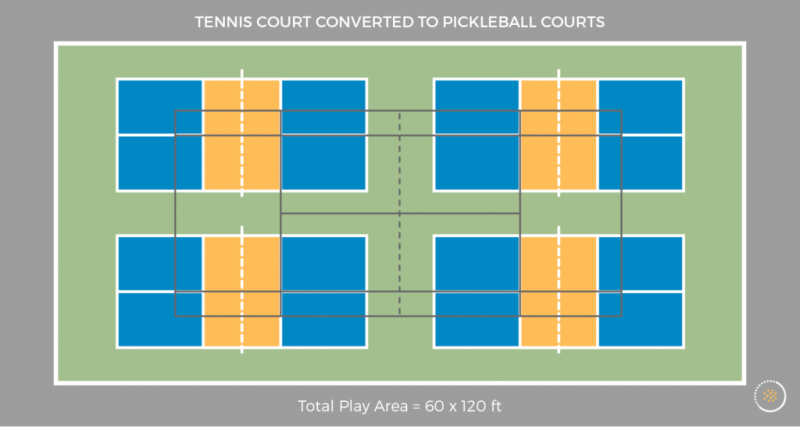
In case you’re wondering, here’s how four pickleball courts could fit on one tennis court. (Illustration: Pickleballfix.com)
Challenge 2: Noise
While playing the game, I’ve never given much thought to the percussive sound of a plastic ball popping off a hard paddle, but it turns out that that sound has become one of the main hindrances to the growth of pickleball countrywide.
“Before I make a commitment to set up a pickleball program somewhere, I’ve learned to physically check out the facility for suitability,” says Geary. “In one nice park on the Mamaroneck/Larchmont border, they wanted me to help them with their underutilized tennis courts. But the courts were completely surrounded by homes with an outdoor café in the near background.” He knew from experience that if they set up a program there, the noise from pickleball paddles and potentially boisterous players at the net could very well become a problem.
If you Google “pickleball noise” you’ll find pages of search results about this contentious issue. Not only have there been lawsuits, but apparently, people in New Jersey are running for their local town board using a ‘pro’ or ‘con’ position on pickleball as the main campaign plank!
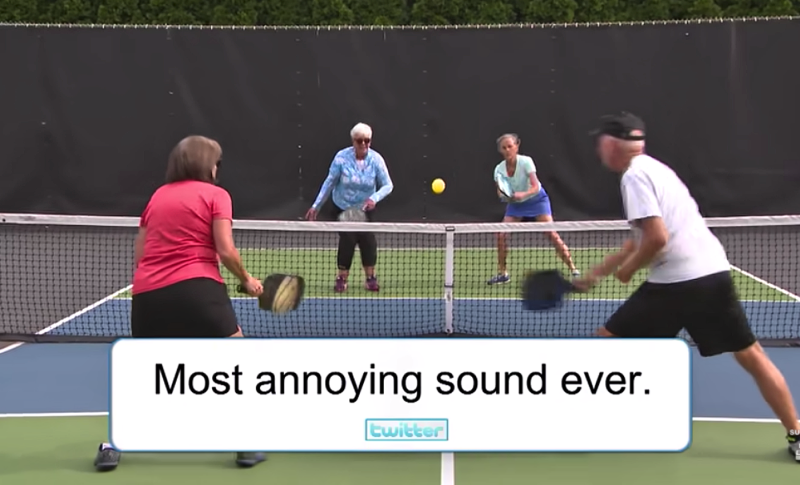
Watch the video
Inside Edition recently aired a story about pickleball noise issues in New Jersey. See their short report below. (And don’t miss the humorous YouTube comments.)
Other states who’ve co-existed with pickleball longer have found some remedies, such as “quiet” paddles and acoustic fencing, but the noise remains a factor in densely populated areas.
Challenge 3: Shadow lines
A popular pickleball motto is “Pickleball: Making tennis courts great again.” In our area parks that’s been proven true over and over again, with Yorktown leading the way by transforming overgrown tennis courts that nobody even remembered existed. Jim Geary proudly shared that, after 6 years of him and others advocating for pickleball courts in Pocantico Hills, last fall the town finished reclaiming Pocantico Hills Central School District’s weed-filled tennis courts for shared pickleball/tennis/basketball use by both students and residents.
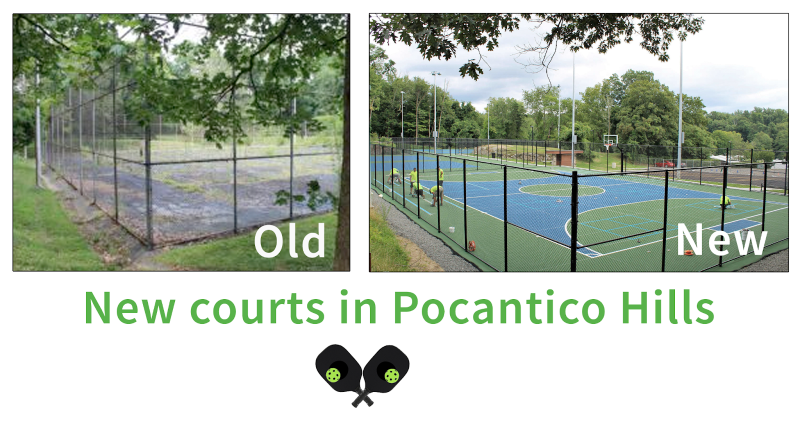
In fall 2021, Pocantico Hills put the finishing touches on a total transformation of unused tennis courts. The sports complex includes shadow lines for two pickleball courts with nighttime lighting. (Photos: Pocantico Hills Central School District website)
So, painted or taped pickleball lines seem to have been accepted on public tennis and basketball courts. But these “shadow lines” have proved an issue in private tennis and fitness clubs. Geary told me about a few area clubs he worked with where “the members there absolutely hated those shadow lines on the tennis courts. And that was the end of that.”
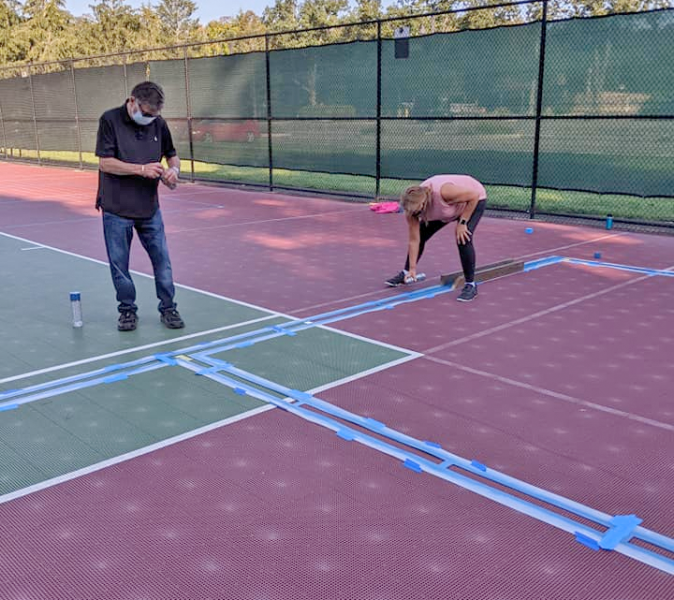
At Reis Park in Somers last summer, volunteers created eight pickleball courts by spray-painting pickleball lines on tennis courts (their Parks and Rec department supplied the templates and paint). (Photo: Teresa L. Chang)
Boya said he’s looking forward to the day when the growing community of pickleball players in Westchester join voices to insist the county provide more dedicated pickleball facilities. “When we get a voice is when we’ll stop getting the scraps, the repurposed paddleball courts, the downtimes of gyms,” he said. “We deserve better than that.”
Challenge 4: A difficult sport to monetize
When I was growing up, badminton was the light racquet sport my school gym program favored. These days, more schools are offering pickleball, and Boya expects p-ball to really take off as kids and their parents realize it’s a fun, fast-paced, lifelong sport that doesn’t require a certain age, gender, or body type.
But until the youths take over, for now, many of the typical pickleball enthusiasts in Westchester fall into two camps — self-employed people who can play during available daytime hours and players aged 50+, in some cases retirees on fixed incomes. That latter cohort, along with beginners dabbling in the game, often look for town parks with free or nominal admission.
This frugality can create a challenge. Recalls Geary, “At the Grand Slam Tennis Club owned by Ivan Lendl in Banksville, the first two seasons we ran the pickleball program, they had a drop-in fee of $5. I met lots of players there. The next season they raised the fee to $8, and people opted out. I asked my friends, Where’d you go? and to my surprise, the cost was the issue.” Grand Slam Tennis no longer lists pickleball as an offering (also partly because of shadow lines complaints from tennis members).
For now, the combination of high property costs and a reluctance of some players to pay up has proved a stumbling block for many local for-profit sports facilities as they try to figure out the magic formula for making money off this up-and-coming game. Same goes for private coaches. (The national pickleball gear sellers seem to be doing fine.)
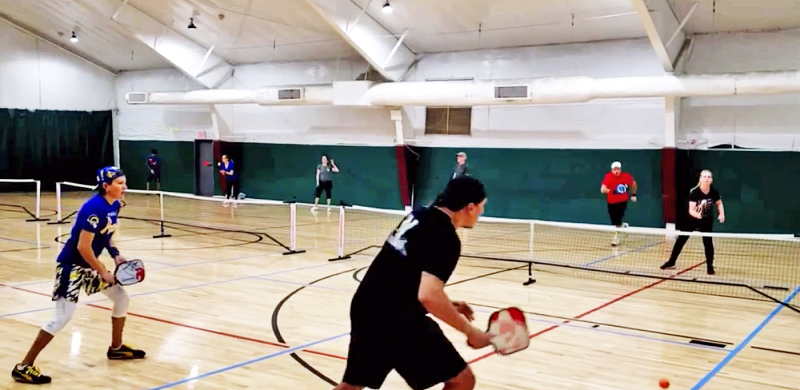
Solaris Sports in Yorktown Heights hopes to crack the money nut with its six indoor pickleball courts which can be rented by the hour. (Photo: Solaris Sports)
Challenge 5: A new sport runs up against old practices
Some Westchester towns have ordinances that hobble the spread and ease of playing pickleball. For instance, Leonard Park in Mount Kisco has a deed restriction that doesn’t allow non-resident instructors to lead an introductory clinic or lessons.
Other towns are putting new pickleball courts behind pricey fees and residents-only locked gates. Frustrated picklers, who willingly range near and far for open courts, report driving by padlocked courts like these on the nicest days of the year, and noticing the courts are beautiful… but empty.
Geary remembers when a simple sign got him in hot water with a town. “We put up a sign at the Yorktown courts saying Here are the times for beginner play on Mon./Weds/Fri, and Here are the times for players at 4.0 and above on Tuesday and Thursday. Well, because it’s a public park it turns out you can’t post a sign like that. But in the end, because we needed some system, people sorted it out themselves and that schedule stuck.”
Challenge 6: Need a point person to make it work
It’s essential to have at least one enthusiastic, dedicated advocate to spearhead a local program — to organize the playing, deal with the venue, set up the portable nets, make sure there’s fair court use so beginners don’t get discouraged, etc. Without that point person, programs can shrivel up or fail to launch at all. Geary says, “We haven’t gotten that person in southern Westchester yet.”
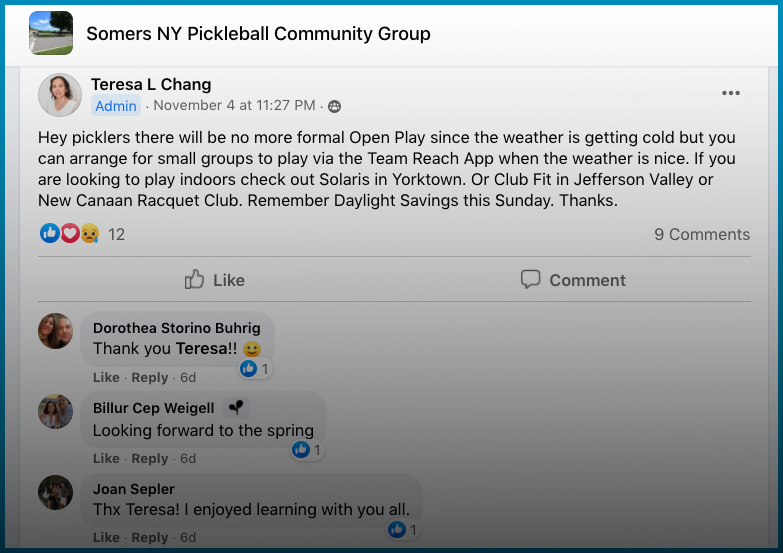
Volunteer pickleball organizers and ambassadors often have day jobs, but keep the balls rolling via Facebook and scheduling apps like TeamReach.
So, yes, there may be a few challenges as enthusiasm for pickleball ramps up to the next level here in Westchester, but one piece of good news is that even if indoor courts are scarce or you’re too cheap to pay the hourly price to rent one, pickleball’s sturdy paddles and durable plastic balls make outdoor cold-weather play more possible than you may think.
“During the pandemic lockdown, when people were leerier of playing indoors during the winter,” says Joy Soleiman, the USA pickleball ambassador for Ridgefield, CT, “we realized that pickleball can be played outside year-round in our area. We just bundle up, check the courts for ice, set up the portable nets, and play! It’s wonderful.”
Jim Geary agrees but says Mother Nature will have the final blustery word about whacking around a lightweight pickleball. “We’ve been doing outdoor play down to 40 degrees. It turns out it’s not the cold that stops us. It’s the wind. When it’s too windy you just have to stop.”
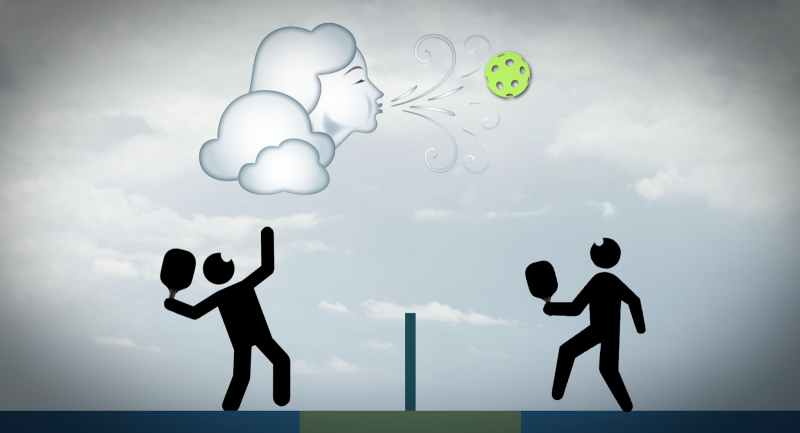
When not writing, editing, or helping clients create their online branding, Laura E. Kelly is on the lookout for fun pickleball games around her home base of Mount Kisco.
We hope you’ve enjoyed today’s section of Examiner+. What did you think? We love honest feedback. Tell us: examinerplus@theexaminernews.com

Examiner Media – Keeping you informed with professionally-reported local news, features, and sports coverage.
